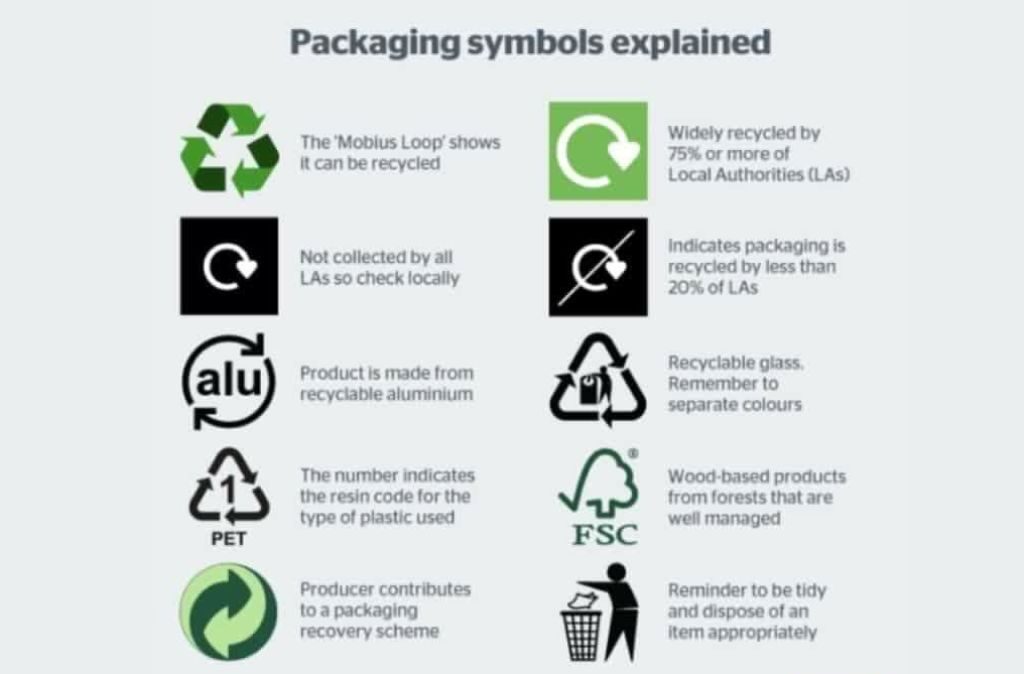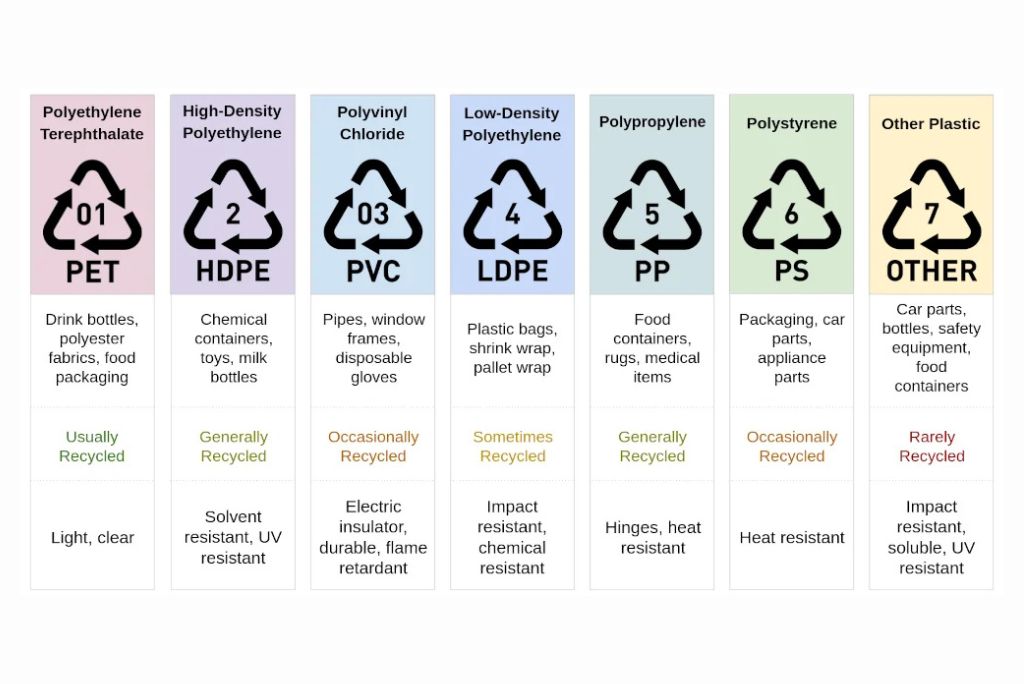Recycling symbols are everywhere—on plastic bottles, cardboard boxes, and even electronic gadgets—but understanding these symbols can be the key to reducing waste and building a sustainable future.
While most people encounter them daily, few know their origins, meanings, and how they contribute to effective recycling.
Let’s dive deep into the world of recycling symbols, their significance, and how they can help you make environmentally conscious decisions.
What Are Recycling Symbols?
Recycling symbols are more than just logos; they are a universal language designed to guide consumers on properly disposing of materials.
The most recognizable is the Mobius Loop—three chasing arrows forming a triangle, first introduced in 1970 during the inaugural Earth Day celebration.
According to EPA.gov, this symbol originally signified products made from recycled materials but has since evolved to indicate recyclability in general.
However, not all recycling symbols are created equal. Some offer straightforward instructions, while others require more profound knowledge.
For example, the resin identification codes on plastics often confuse even diligent recyclers.
Understanding these symbols is crucial because incorrect recycling can contaminate entire batches of recyclable materials, sending them to landfills instead.
Decoding the On-Pack Recycling Label (OPRL)

The On-Pack Recycling Label (OPRL) is a standardized system primarily used in the UK but gaining traction globally.
This labeling system provides straightforward, actionable instructions for consumers, often simplifying complex recycling guidelines.
Common Labels and Their Meanings
- Widely Recycled: This label indicates that over 75% of local recycling programs accept the material, making it a straightforward choice for consumers aiming to recycle correctly.
- Check Locally: This prompts consumers to verify whether their local recycling facilities can process the item. Materials with this label often face logistical or technological challenges, as not all facilities are equipped to handle them.
- Not Yet Recycled: Items with this label are currently unsuitable for standard recycling processes due to lack of infrastructure, technology, or economic feasibility.
Products marked with the “Check Locally” label often require specialized facilities, which are unavailable in every region.
For example, black plastic trays pose significant recycling challenges because their dark color makes them difficult for sorting machines to detect.
This limitation highlights the importance of local recycling capabilities and the need for ongoing innovation in recycling technologies.
By adopting these simplified labels, countries and organizations aim to demystify recycling and increase participation rates, ultimately driving a global push towards a more sustainable future.
Understanding the Plastic Resin Codes (Recycling Symbols 1–7)
 Plastic items often display a number inside the familiar Mobius Loop, representing one of seven different types of plastic resins.
Plastic items often display a number inside the familiar Mobius Loop, representing one of seven different types of plastic resins.
These numbers play a critical role in helping recycling facilities sort and process plastics efficiently, reducing contamination and improving recycling outcomes.
Here’s a closer look at what each number means and how it affects recyclability.
Breaking Down the Numbers
#1 (PET – Polyethylene Terephthalate)
- Common Uses: Water bottles, soda bottles, and food containers.
- PET is one of the most recyclable plastics. It’s lightweight, clear, and widely accepted by recycling programs. However, it has limitations, as it can only be recycled into similar items a finite number of times due to degradation in quality during the recycling process.
#2 (HDPE – High-Density Polyethylene)
- Common Uses: Milk jugs, detergent bottles, and shampoo containers.
- HDPE is valued for its strength and durability. It’s also highly recyclable, making it a popular choice for manufacturers aiming to produce sustainable products. Items made from recycled HDPE include pipes, plastic lumber, and more bottles.
#3 (PVC – Polyvinyl Chloride)
- Common Uses: Plumbing pipes, vinyl flooring, and some food wraps.
- PVC is challenging to recycle due to its chemical makeup, which can release harmful substances during processing. Specialized facilities can handle it, but such options are limited, making PVC one of the least recyclable plastics.
#4 (LDPE – Low-Density Polyethylene)
- Common Uses: Grocery bags, shrink wrap, and squeezable bottles.
- Although LDPE can technically be recycled, many facilities do not accept it because it’s lightweight and prone to contamination. Efforts are underway to improve LDPE recycling, particularly for applications like producing composite lumber.
#5 (PP – Polypropylene)
- Common Uses: Yogurt containers, bottle caps, straws, and medicine bottles.
- Polypropylene’s recycling rate is gradually increasing as new technologies emerge. However, it still faces barriers due to its varied uses and the difficulty of collecting clean, uncontaminated PP materials.
#6 (PS – Polystyrene)
- Common Uses: Yogurt containers, bottle caps, straws, and medicine bottles.
- Polystyrene is one of the least recycled plastics. It breaks easily into microplastics, posing environmental risks. While recycling programs for PS exist, they are few, and the material is often excluded from curbside collections.
#7 (Other)
- Common Uses: A diverse category that includes polycarbonate, bioplastics, and mixed plastics used in items like electronics, large water bottles, and compostable plastics.
- This catch-all category includes materials that are hard to classify and recycle. Some #7 plastics, like bioplastics, are compostable under specific conditions, but others require advanced recycling methods, making them challenging to process on a large scale.
Exploring Other Recycling Symbols
Beyond plastics, recycling symbols apply to glass, aluminum, and electronics. Each symbol carries unique instructions.
Glass Recycling Symbols
A simple broken bottle icon indicates that the material is recyclable, but only when free of contaminants like ceramics or lids.
Aluminum Recycling Symbols
Aluminum cans often bear the Mobius Loop along with a reminder of its infinite recyclability.
According to Aluminum.org, recycling aluminum saves 95% of the energy required to produce it from raw materials.
Compostable Symbols
Compostable items carry symbols like a leaf or plant. These items break down into organic material under specific conditions but should not be confused with biodegradable items, which may still leave microplastics behind.
Electronic Waste Symbols
A crossed-out wheeled bin warns that electronic items require specialized recycling. E-waste contains hazardous materials like mercury but also valuable metals like gold and copper.
Why Is Recycling Important?
Recycling is not just a moral responsibility; it has tangible benefits for the environment, economy, and society.
Environmental Impact
Recycling reduces the need for raw material extraction, conserving resources and preventing habitat destruction.
It also minimizes greenhouse gas emissions by lowering energy use in production processes.
Economic Benefits
The recycling industry generates millions of jobs globally. In the U.S. alone, it supports over 1.1 million jobs, as per a study by ISRI.
Social Responsibility
Encouraging recycling promotes community engagement and accountability, fostering a collective effort toward sustainability.
Best Practices for Recycling at Home
Should You Clean an Item Before Recycling It?
Yes, but only lightly. Rinsing containers to remove food residue prevents contamination, which can render entire batches of recyclables unusable.
However, avoid using excessive water—strike a balance to save resources.
Avoiding Contamination
Common contaminants include greasy pizza boxes and broken glass. Separate non-recyclables to avoid “wish-cycling,” which creates inefficiencies.
Sorting Tips
- Keep paper and cardboard dry.
- Crush cans and bottles to save space.
- Avoid placing items in plastic bags unless explicitly required by your recycling program.
Conclusion
Recycling symbols serve as a bridge between consumers and sustainable practices, but their complexity can be overwhelming.
By decoding these symbols and adopting best practices, we can collectively reduce waste and support a circular economy.
Take a moment to examine the packaging around you and reflect on its lifecycle.
With a little effort and awareness, you can ensure that your recycling habits make a lasting impact.
For businesses and organizations looking to revolutionize their waste management processes, BurCell offers innovative solutions designed to optimize recycling and resource recovery.
Contact BurCell today to explore how our cutting-edge waste management solutions can help you succeed in creating a sustainable future.
Together, we can transform waste systems into a cornerstone of environmental preservation.
FAQs
What are the most common recycling symbols and what do they mean?
The most common recycling symbols include the Mobius Loop, resin identification codes (numbers 1-7 in triangles), and chasing arrows with percentages. The Mobius Loop generally indicates the item can be recycled, while resin codes specify the type of plastic. Chasing arrows with percentages show the material’s recycled content.
How do I know if an item is actually recyclable in my area?
Local recycling programs have specific guidelines. Check your city or county’s waste management website or contact them directly. Some materials may be accepted curbside, while others require drop-off at designated centers. Always rinse and clean containers before recycling.
What are the common misconceptions about recycling?
Many people mistakenly believe that all plastics with the recycling symbol are recyclable. However, the symbol only indicates the type of plastic, not its recyclability in your area. Additionally, contamination (food residue, liquids) can make items unrecyclable.
How can I reduce my waste and improve my recycling habits?
Reduce consumption by choosing reusable alternatives (bags, bottles, containers). Avoid single-use items whenever possible. Compost food scraps and yard waste. Learn about your local recycling guidelines and participate actively in community recycling programs.
Why is it important to understand recycling symbols and practice proper waste management?
Proper recycling conserves natural resources, reduces landfill waste, and minimizes environmental pollution. Understanding recycling symbols helps you make informed decisions about how to dispose of your waste, maximizing recycling efforts and contributing to a more sustainable future.

